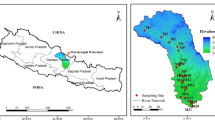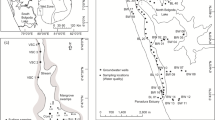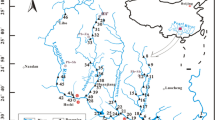Abstract
The hydrochemistry of alpine lakes reflects water characteristic and its response to climatic change. Over 300 water samples had been collected from 52 sites of 5 lakes and 7 inflowing rivers in the Yamzhog Yumco Basin, South Tibet, during 2009–2014, basing which the hydrochemical regime and its mechanism were analyzed along with the adoption of hydrological investigations in 1979 and 1984 as well. Results revealed that the waters were hard with weak alkalinity for the Yamzhog Yumco Basin. Most of them were fresh, and the rest were slightly saline. The hydrochemical types of 5 lakes (i.e., Lake Yamzhog Yum Co, Puma Yum Co, Bajiu Co, Kongmu Co, and Chen Co) were SO4 2––HCO3 ––Mg2+–Na+, HCO3 ––SO4 2––Mg2+–Ca2+, SO4 2––Mg2+–Na+, SO4 2––HCO3 ––Ca2+, and SO4 2––Na+–Mg2+–Ca2+, respectively. As for rivers, HCO3 – and SO4 2– were the major anions, and Ca2+ was the dominant cation. Lake Yamzhog Yum Co, the largest lake in the basin, exhibited remarkable spatial variations in hydrochemistry at its surface but irregular changes with depth. The weathering of evaporates and carbonates, together with evaporation and crystallization, were the major mechanisms controlling the hydrochemistry of waters in the Yamzhog Yumco Basin. Global warming also had significant impacts on hydrochemical variations.
Similar content being viewed by others
References
Bianduo, Bianbaciren, Li L et al., 2009. The response of lake change to climate fluctuation in north Qinghai-Tibet Plateau in last 30 years. Journal of Geographical Sciences, 19(2): 131–142.
Chen J S, Wang F Y, Xia X H et al., 2002. Major element chemistry of the Changjiang (Yangtze River). Chemical Geology, 187(3): 231–255.
Chen X P, 1990. On the change of water environment in Yangzhuoyong Lake, Tibet. Oceanologia et Limnologia Sinica, 21(3): 285–293. (in Chinese)
Chu D, Pu Qiong, Labazhuoma et al., 2012. Remote sensing analysis on lake area variations of Yamzho Yumco in Tibetan Plateau over the past 40a. Journal of Lake Sciences, 24(3): 494–502. (in Chinese)
Cui B L, Li X Y, 2014. Characteristics of stable isotopes and hydrochemistry of river water in the Qinghai Lake Basin, northeast Qinghai-Tibet Plateau, China. Environmental Earth Sciences, 73(8): 4251–4263.
Du J, Hu J, Tang S J et al., 2008. Climatic variations of temperature and precipitation in the Yamzho Yumco Lake Basin of Tibet from 1961 to 2005. Acta Geographica Sinica, 63(11): 1160–1168. (in Chinese)
ESRI, 2013. ArcGIS Desktop: Release 10.2.
Gaillardet J, DupréB, Louvat P et al., 1999. Global silicate weathering and CO2 consumption rates deduced from the chemistry of large rivers. Chemical Geology, 159(1–4): 3–30.
Gibbs R J, 1970. Mechanisms controlling world water chemistry. Science, 170(3962): 1088–1090.
Guan Z, Chen C, Qu Y et al., 1984. Rivers and Lakes in Tibet. Beijing: Science and Technology Press. (in Chinese)
Huang L, Liu J Y, Shao Q Q et al., 2011. Changing inland lakes responding to climate warming in Northeastern Tibetan Plateau. Climatic Change, 109(3): 479–502.
Immerzeel W W, van Beek L P H, Bierkens M F P, 2010. Climate change will affect the Asian water towers. Science, 328(5984): 1382–1385.
Jiang L G, Yao Z J, Liu Z F et al., 2015. Hydrochemistry and its controlling factors of rivers in the source region of the Yangtze River on the Tibetan Plateau. Journal of Geochemical Exploration, 155: 76–83.
Ju J T, Zhu L P, Wang J B et al., 2010. Water and sediment chemistry of Lake Pumayum Co, South Tibet, China: Implications for interpreting sediment carbonate. Journal of Paleolimnology, 43(3): 463–474.
Kang S C, Xu Y W, You Q L et al., 2010. Review of climate and cryospheric change in the Tibetan Plateau. Environmental Research Letters, 5(1): 75–82.
Lerman A, Imboden D, Gat J, 1995. Physics and Chemistry of Lakes. New York: Springer.
Li P Y, Qian H, Wu J H et al., 2013. Major ion chemistry of shallow groundwater in the Dongsheng Coalfield, Ordos Basin, China. Mine Water and the Environment, 32(3): 195–206.
Li Z G, 2014. Glacier and lake changes across the Tibetan Plateau during the past 50 years of climate change. Journal of Resources and Ecology, 5(2): 123–131.
Maidment D R, 1993. Handbook of Hydrology. New York: McGraw-Hill.
Meybeck M, 1987. Global chemical weathering of surficial rocks estimated from river dissolved loads. American Journal of Science, 287(5): 401–428.
Ministry of Environmental Protection, 2002. Environmental Quality Standard for Surface Water, GB 3838–2002. Beijing.
Piper A M, 1944. A graphic procedure in the geochemical interpretation of water analyses. Eos, Transactions American Geophysical Union, 25(6): 914–923.
Shi W G, 1995. Impact of yangzhuoyong lake hydropower on ecological environment in Tibet. Journal of Lake Sciences, 7(2): 178–184. (in Chinese)
Smolders A J P, Hudson-Edwards K A, Van der Velde G et al., 2004. Controls on water chemistry of the Pilcomayo river (Bolivia, South-America). Applied Geochemistry, 19(11): 1745–1758.
Song C Q, Huang B, Ke L H et al., 2014a. Remote sensing of alpine lake water environment changes on the Tibetan Plateau and surroundings: A review. ISPRS Journal of Photogrammetry and Remote Sensing, 92(2): 26–37.
Song C Q, Huang B, Ke L H et al., 2014b. Seasonal and abrupt changes in the water level of closed lakes on the Tibetan Plateau and implications for climate impacts. Journal of Hydrology, 514: 131–144.
Song C Q, Huang B, Richards K S et al., 2014c. Accelerated lake expansion on the Tibetan Plateau in the 2000s: Induced by glacial melting or other processes? Water Resources Research, 50(4): 3170–3186.
Stein M L, 1999. Interpolation of Spatial Data: Some Theory for Kriging. New York: Springer.
Sun R, Zhang X Q, Sun Y et al., 2013a. SWAT-based streamflow estimation and its responses to climate change in the Kadongjia River watershed, southern Tibet. Journal of Hydrometeorology, 14(5): 1571–1586.
Sun R, Zhang X Q, Tian Y, 2012a. Spatial differentiation of water chemical property in Yamzhog Yumco, South Tibet. Environment Science & Technology, 35(11): 16–20. (in Chinese)
Sun R, Zhang X Q, Wu Y H, 2012b. Major ion chemistry of water and its controlling factors in the Yamzhog Yumco Basin, South Tibet. Journal of Lake Sciences, 24(4): 600–608. (in Chinese)
Sun R, Zhang X Q, Zheng D, 2013b. Spatial variation and its causes of water chemical property in Yamzhog Yumco Basin, South Tibet. Acta Geographica Sinica, 68(1): 36–44. (in Chinese)
Tian Y, Yu C Q, Luo K L et al., 2015. Hydrochemical characteristics and element contents of natural waters in Tibet, China. Journal of Geographical Sciences, 25(6): 669–686.
Tian Y, Zhang X Q, Sun R, 2012. Extracting alpine lake information based on multi-source and multi-temporal satellite images and its uncertainty analysis. Journal of Glaciology and Geocryology, 34(3): 563–572. (in Chinese)
Tibet Statistical Bureau, 2015. Tibet Statistical Yearbook in 2014. Beijing: China Statistics Press. (in Chinese)
Wang J B, Ju J T, Zhu L P, 2013. Water chemistry variations of lake and inflowing rivers between pre- and post-monsoon season in Nam Co, Tibet. Scientia Geographica Sinica, 33(1): 90–96. (in Chinese)
Wang S M, Dou H S, Chen K et al., 1998. Lakes of China. Beijing: Science Press. (in Chinese)
Winston R B, 2000. Graphical User Interface for MODFLOW Version 4. U.S. Geological Survey.
Wu W H, 2016. Hydrochemistry of inland rivers in the north Tibetan Plateau: Constraints and weathering rate estimation. Science of The Total Environment, 541: 468–482.
Xiao J, Jin Z D, Ding H et al., 2012a. Geochemistry and solute sources of surface waters of the Tarim River Basin in the extreme arid region, NW Tibetan Plateau. Journal of Asian Earth Sciences, 54/55: 162–173.
Xiao J, Jin Z D, Zhang F et al., 2012b. Major ion geochemistry of shallow groundwater in the Qinghai Lake catchment, NE Qinghai-Tibet Plateau. Environmental Earth Sciences, 67(5): 1331–1344.
Yan L, Zheng M, 2015. Influence of climate change on saline lakes of the Tibet Plateau, 1973–2010. Geomorphology, 246: 68–78.
Yao Z J, Wang R, Liu Z F et al., 2015. Spatial-temporal patterns of major ion chemistry and its controlling factors in the Manasarovar Basin, Tibet. Journal of Geographical Sciences, 25(6): 687–700.
Ye Q H, Zhu L P, Zheng H X et al., 2007. Glacier and lake variations in the Yamzhog Yumco basin, southern Tibetan Plateau, from 1980 to 2000 using remote-sensing and GIS technologies. Journal of Glaciology, 53(183): 673–676.
Yu S M, Liu J S, Yuan J G, 2010. Vegetation change of Yamzho Yumco Basin in southern Tibet based on SPOT-VGT NDVI. Spectroscopy and Spectral Analysis, 30(6): 1570–1574. (in Chinese)
Zang Y L, Wang J L, Tian L D et al., 2014. The spatial distribution of stable isotopes in Yamzho Yumco Lake. Journal of Southwest University, 36(4): 127–132 (in Chinese)
Zhang G Q, Xie H J, Kang S C et al., 2011. Monitoring lake level changes on the Tibetan Plateau using ICESat altimetry data (2003–2009). Remote Sensing of Environment, 115(7): 1733–1742.
Zhang G Q, Yao T D, Xie H J et al., 2014a. Lakes’ state and abundance across the Tibetan Plateau. Chinese Science Bulletin, 59(24): 3010–3021.
Zhang Q G, Kang S C, Wang F Y et al., 2008. Major ion geochemistry of Nam Co Lake and its sources, Tibetan Plateau. Aquatic Geochemistry, 14(4): 321–336.
Zhang X, Wu Y H, Zhang X, 2014b. Water level variation of inland lakes on the south-central Tibetan Plateau in 1972–2012. Acta Geographica Sinica, 69(7): 993–1101. (in Chinese)
Zhang X Q, Sun R, Zhu L P, 2012. Lake water in the Yamzhog Yumco Basin in South Tibetan region: quality and evaluation. Journal of Glaciology and Geocryology, 34(4): 950–958. (in Chinese)
Zhe M, Zhang X Q, Sun R et al., 2016. Assessment of water quality and the pollution factors of waters in Yamzhog Yumco Basin, Tibet. Journal of Lake Sciences, 28(2): 287–294. (in Chinese)
Zheng M P, Liu X F, 2009. Hydrochemistry of salt lakes of the Qinghai-Tibet Plateau, China. Aquatic Geochemistry, 15(1–2): 293–320.
Zheng W, Yao T D, Xu B Q et al., 2008. Ionic chemistry in snowpits from Yamzhog Yumco Basion. Environmental Science, 29(6): 1488–1494. (in Chinese)
Zhou S Q, Kang S C, Gao T G et al., 2010. Response of Zhadang Glacier runoff in Nam Co Basin, Tibet, to changes in air temperature and precipitation form. Chinese Science Bulletin, 55(20): 2103–2110.
Zhu L P, Ju J T, W J B et al., 2006. Environmental changes recorded in core sediments from the Pumoyum Co Lake of the Tibetan Plateau during the initial stage of the last deglacial period. Quaternary Sciences, 26(5): 772–780. (in Chinese)
Zhu L P, Ju J T, Wang J B et al., 2010a. Further discussion about the features of Lake Puma Yum Co, South Tibet, China. Limnology, 11(3): 281–287.
Zhu L P, Ju J T, Wang Y et al., 2010b. Composition, spatial distribution, and environmental significance of water ions in Pumayum Co catchment, southern Tibet. Journal of Geographical Sciences, 20(1): 109–120.
Zhu L P, Xie M P, Wu Y H, 2010c. Quantitative analysis of lake area variations and the influence factors from 1971 to 2004 in the Nam Co basin of the Tibetan Plateau. Chinese Science Bulletin, 55(13): 1294–1303.
Author information
Authors and Affiliations
Corresponding author
Additional information
Foundation National Natural Science Foundation of China, No.41471064, No.41171062
Rights and permissions
About this article
Cite this article
Zhe, M., Zhang, X., Wang, B. et al. Hydrochemical regime and its mechanism in Yamzhog Yumco Basin, South Tibet. J. Geogr. Sci. 27, 1111–1122 (2017). https://doi.org/10.1007/s11442-017-1425-1
Received:
Accepted:
Published:
Issue Date:
DOI: https://doi.org/10.1007/s11442-017-1425-1




